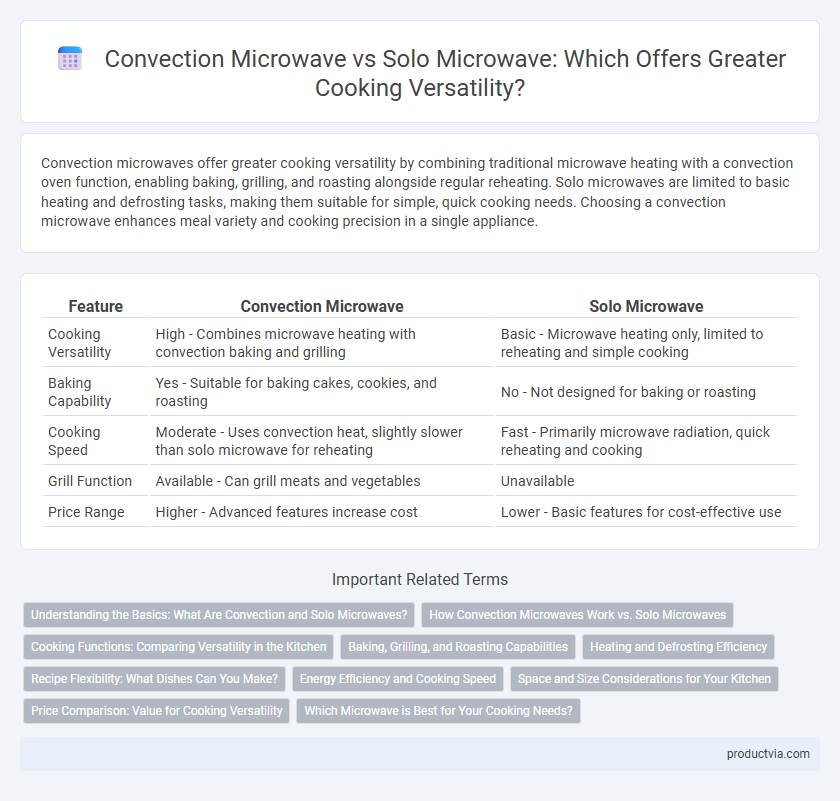Convection microwaves offer greater cooking versatility by combining traditional microwave heating with a convection oven function, enabling baking, grilling, and roasting alongside regular reheating. Solo microwaves are limited to basic heating and defrosting tasks, making them suitable for simple, quick cooking needs. Choosing a convection microwave enhances meal variety and cooking precision in a single appliance.
Table of Comparison
| Feature | Convection Microwave | Solo Microwave |
|---|---|---|
| Cooking Versatility | High - Combines microwave heating with convection baking and grilling | Basic - Microwave heating only, limited to reheating and simple cooking |
| Baking Capability | Yes - Suitable for baking cakes, cookies, and roasting | No - Not designed for baking or roasting |
| Cooking Speed | Moderate - Uses convection heat, slightly slower than solo microwave for reheating | Fast - Primarily microwave radiation, quick reheating and cooking |
| Grill Function | Available - Can grill meats and vegetables | Unavailable |
| Price Range | Higher - Advanced features increase cost | Lower - Basic features for cost-effective use |
Understanding the Basics: What Are Convection and Solo Microwaves?
Convection microwaves combine traditional microwave heating with a built-in fan and heating element, allowing for baking, roasting, and grilling alongside standard microwaving, enhancing cooking versatility. Solo microwaves operate solely with microwave radiation, making them ideal for reheating and simple cooking tasks but lacking the ability to brown or crisp food. Understanding these fundamental differences helps determine which microwave suits varied culinary needs, with convection models offering greater flexibility for complex recipes.
How Convection Microwaves Work vs. Solo Microwaves
Convection microwaves combine microwave radiation with a heating element and fan that circulate hot air, enabling both baking and roasting alongside standard microwaving. Solo microwaves use only microwave radiation to heat and cook food, making them ideal for simple reheating and basic cooking tasks. This dual functionality in convection models offers greater cooking versatility compared to the single-function operation of solo microwaves.
Cooking Functions: Comparing Versatility in the Kitchen
Convection microwaves combine traditional microwave heating with convection oven capabilities, enabling baking, grilling, and roasting alongside standard reheating, offering greater cooking versatility. Solo microwaves primarily focus on basic heating and defrosting functions, limiting their use to simpler cooking tasks. For kitchens requiring diverse cooking methods, convection microwaves provide enhanced multifunctionality compared to solo models.
Baking, Grilling, and Roasting Capabilities
Convection microwaves combine microwave energy with a convection heating element, enabling efficient baking, grilling, and roasting with evenly cooked results and crispy textures. Solo microwaves primarily rely on microwave radiation for simple reheating and basic cooking, lacking advanced features for browning or crisping foods. For versatile cooking tasks like baking cakes, grilling meats, and roasting vegetables, convection microwaves offer significantly greater functionality and culinary flexibility.
Heating and Defrosting Efficiency
Convection microwaves combine microwave energy with a heating element, enabling faster and more even heating as well as efficient defrosting by circulating hot air, making them ideal for cooking a wider variety of foods. Solo microwaves rely solely on microwave radiation for heating, which can lead to uneven defrosting and limited cooking versatility. The convection feature enhances browning and crisping, offering superior results for baking and roasting compared to conventional solo models.
Recipe Flexibility: What Dishes Can You Make?
Convection microwaves offer enhanced recipe flexibility by combining microwave energy with a heating element and a fan, enabling baking, roasting, and grilling in addition to standard reheating, making them ideal for versatile cooking such as casseroles, cakes, and roasted meats. Solo microwaves, while efficient for simple tasks like reheating, defrosting, and basic cooking, lack the advanced heating capabilities, limiting their use to steaming, reheating, and simple microwave dishes like popcorn or instant meals. Choosing a convection microwave unlocks a broader range of culinary possibilities, supporting complex recipes that require dry heat cooking methods.
Energy Efficiency and Cooking Speed
Convection microwaves combine microwave energy with a heating element and fan, enabling faster cooking and baking with even heat distribution, which enhances energy efficiency by reducing cooking time. Solo microwaves use only microwave radiation, making them more energy-efficient for simple tasks but slower and less versatile for complex cooking that requires browning or crisping. Choosing a convection microwave offers superior cooking versatility and speed, especially for recipes demanding multiple cooking methods, while solo microwaves excel in energy-saving for basic reheating and defrosting.
Space and Size Considerations for Your Kitchen
Convection microwaves offer enhanced cooking versatility by combining microwave energy with a heating element, enabling baking, grilling, and roasting in addition to standard reheating, but they typically have larger dimensions that require more kitchen space. Solo microwaves are compact and ideal for small kitchens or limited counter areas, making them perfect for simple tasks like reheating and basic cooking without the bulk of convection features. When choosing between the two, consider your kitchen's available counter space and cooking needs to balance functionality with spatial constraints.
Price Comparison: Value for Cooking Versatility
Convection microwaves offer enhanced cooking versatility with features like baking and grilling, often priced higher than solo microwaves, which are primarily designed for simple reheating and defrosting tasks. Investing in a convection microwave delivers greater value for users seeking multifunctional cooking capabilities without purchasing separate appliances. Solo microwaves remain a cost-effective choice for basic heating needs but lack the advanced cooking options that convection models provide.
Which Microwave is Best for Your Cooking Needs?
Convection microwaves offer enhanced cooking versatility by combining microwave energy with a heating element and fan, allowing for baking, roasting, and crisping alongside standard reheating. Solo microwaves are ideal for simple tasks such as defrosting and heating, making them a budget-friendly option with straightforward controls. Choosing the best microwave depends on whether you need multifunctional cooking capabilities or just basic microwave functionality for everyday heating needs.
Convection Microwave vs Solo Microwave for Cooking Versatility Infographic

 productvia.com
productvia.com